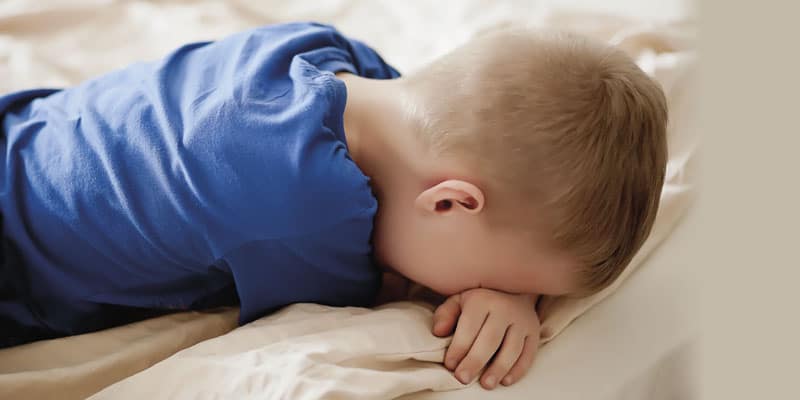Kelley Richardson shares her first-hand results of myofunctional therapy on her own son’s sleep-breathing habits.
 by Kelley Richardson
by Kelley Richardson
Until our son, Finn, was 6 years old, he had not slept through the night… We thought we had tried everything, and we were tired. It never occurred to us to look at how he was breathing.
Look closely… is your child breathing through their nose or mouth?
It turned out, Finn was a mouth breather. We had no idea his mouth breathing habit led to nasal congestion. We learned that an open mouth posture makes it harder to get restorative sleep. Sleep quantity is not always synonymous with deep, quality sleep.
He was a restless sleeper. Tossing and turning, he would repeatedly call out through the night for help. His breathing was labored, he was sweating profusely during naps and at night. He suffered from nightmares and dark circles under his eyes. Despite waking up tired and yawning, he had an abundance of energy throughout the day. He developed eczema on his face and was congested to the point of trying to clear his nose and throat several times a minute. He was clearly in distress.
Was it Physiology? Allergies? Diet?
After years of doctor appointments and medications, we were still no closer to finding the root cause. Until a conversation with a dentist. The dentist explained how the nose filters, warms, purifies and humidifies the air coming into our body. Mouth breathing doesn’t do this but instead can lead to nasal congestion and enlargement of tonsils and adenoids, as well as other forms of inflammation. The first step to resolving his fragmented sleep and disordered breathing was to transform Finn’s breathing habit from mouth breathing to nose breathing.
This was the beginning of our journey to helping our son sleep and breathe better, but it was a very crucial first step. After breathing retraining, Finn benefited from a lingual frenectomy (before frenuloplasty was taught), myofunctional therapy and expansion orthodontics. Seeing first-hand the results of early treatment on Finn’s improved quality of sleep has made me an advocate of early intervention. It’s not uncommon for me to discuss the phenotypes of sleep and breathing disorders with teachers, coaches and parents. I am often handing out Breathe Right strips and demonstrating the Cottle maneuver on school trips, baseball fields, and playdates.
I feel fortunate to have learned this message while my son was still young enough to benefit from early treatment. Having worked on the business side of dentistry for 25 years, I am encouraged and grateful for the growing number of dentists passionate about screening and treating Sleep Related Breathing Disorders. When you are treating a child, you are helping the entire family breathe easier. As Ralph Waldo Emerson said, “To know even one life has breathed easier because you have lived. This is to have succeeded.”
 Kelley Richardson is the founder of SuperBreathers.com. She is the author of The Very Stuffy Nose children’s book and co-author of CHICAGO HEARTS Patient, Parent and Teacher Education Guide on sleep related breathing disorder phenotypes with Dr. Kevin Boyd. She has worked for Dentsply, Align Technology, The Dawson Academy, Straumann, and uLab Systems. She has completed the Dawson Academy Core Curriculum, the Buteyko Clinic Instructors Certification Course, and has received her Orofacial Myofunctional Therapy certificate from the AOMT. She is a member of AAPMD and AAOSH.
Kelley Richardson is the founder of SuperBreathers.com. She is the author of The Very Stuffy Nose children’s book and co-author of CHICAGO HEARTS Patient, Parent and Teacher Education Guide on sleep related breathing disorder phenotypes with Dr. Kevin Boyd. She has worked for Dentsply, Align Technology, The Dawson Academy, Straumann, and uLab Systems. She has completed the Dawson Academy Core Curriculum, the Buteyko Clinic Instructors Certification Course, and has received her Orofacial Myofunctional Therapy certificate from the AOMT. She is a member of AAPMD and AAOSH.